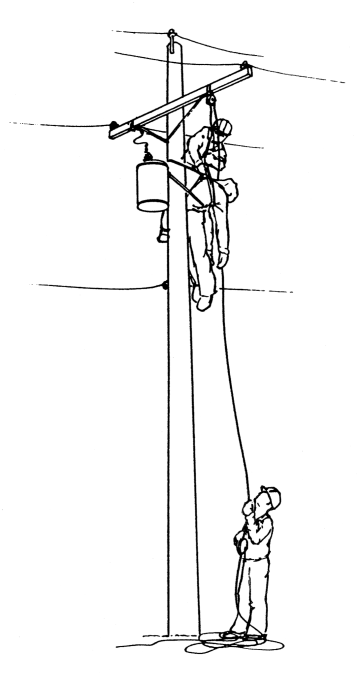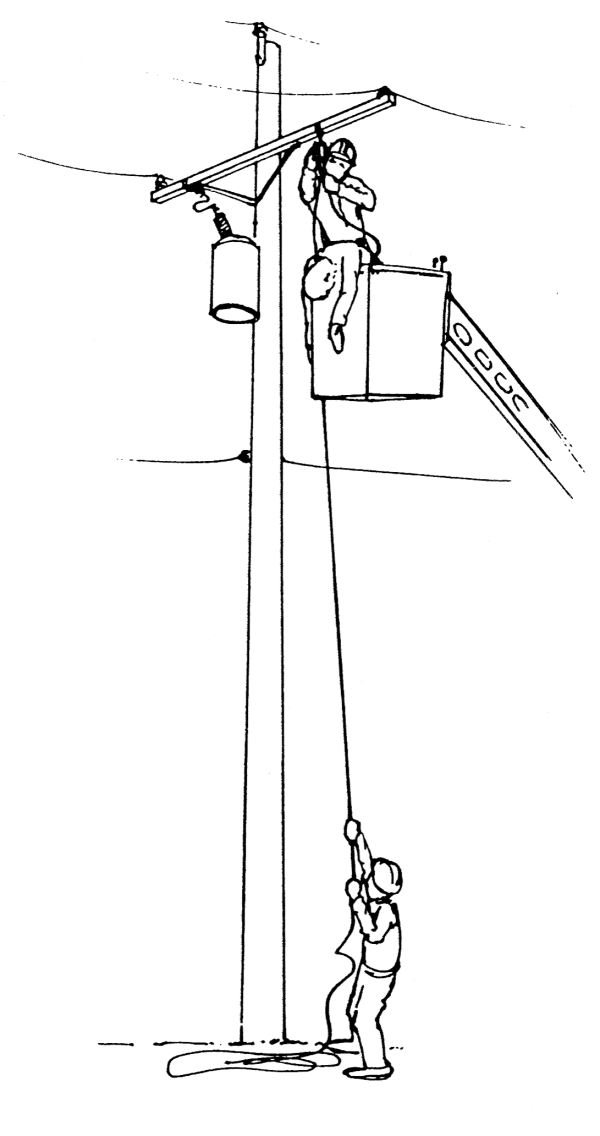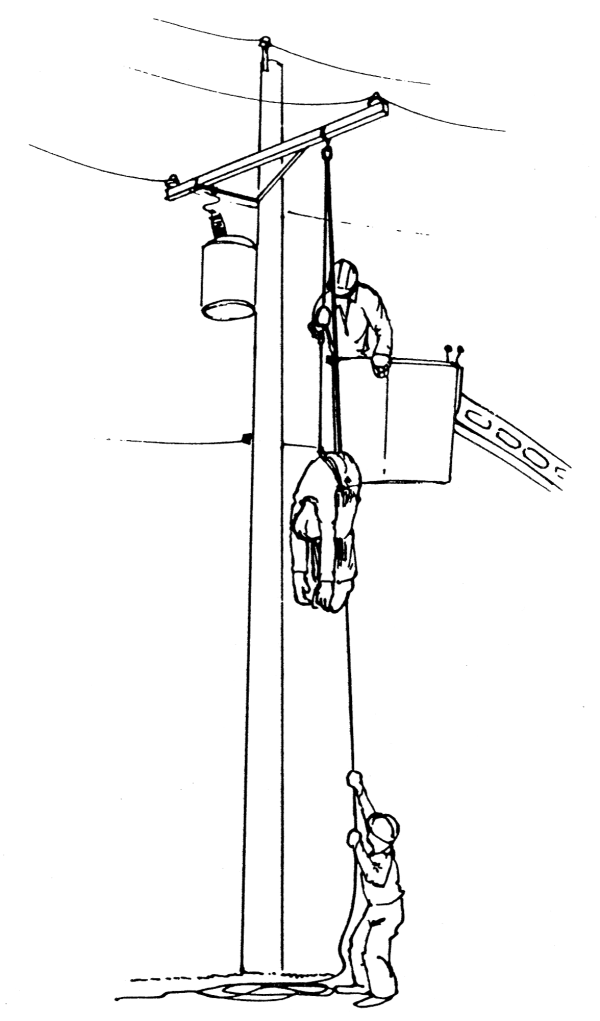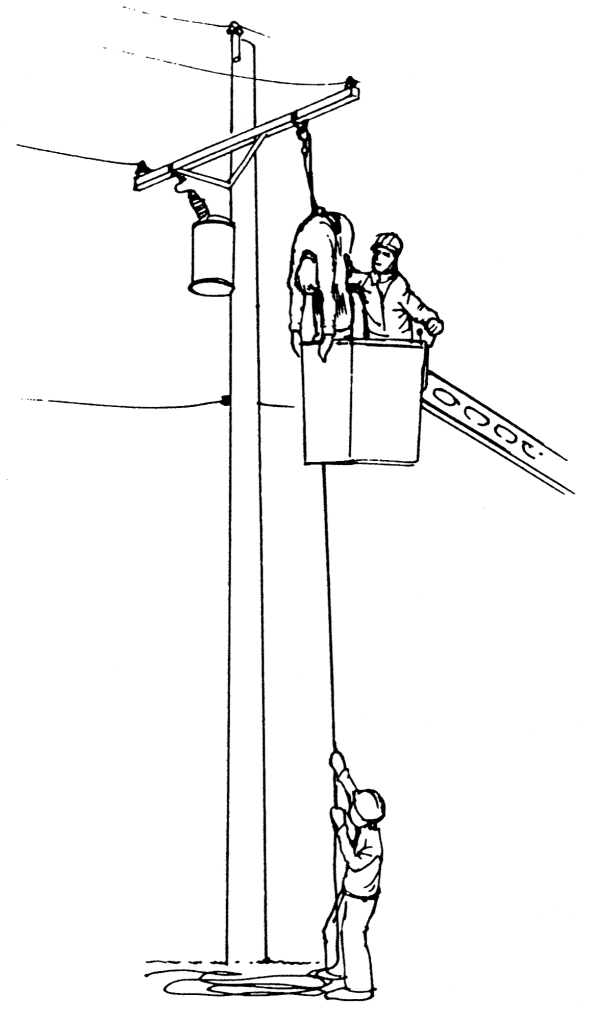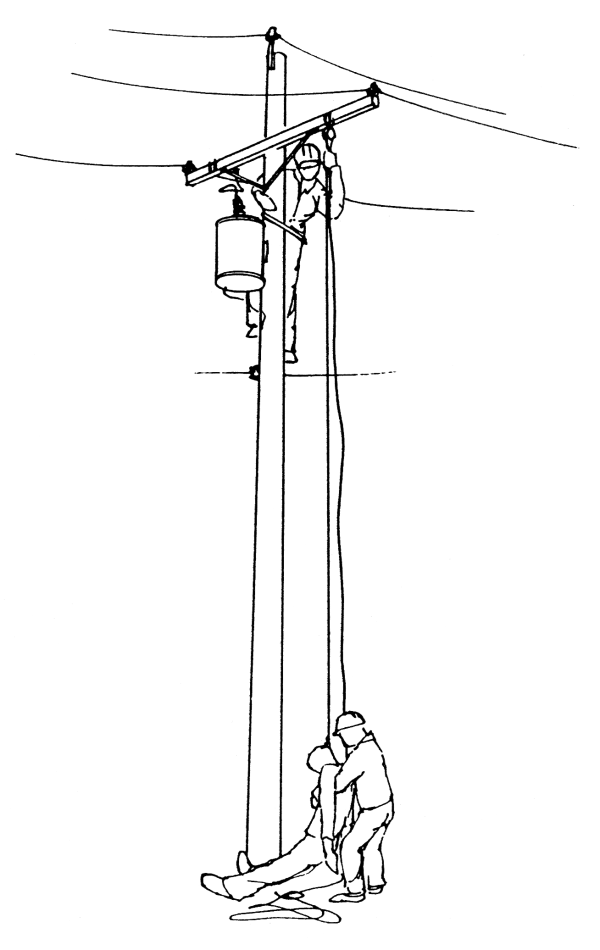Pole Top, Tree, Tower & Bucket Rescue
Revised January 2024
When the need for pole top, bucket or tree rescue arises it is important the rescuer is prepared and able to follow the procedures outlined in this section.
Employees engaged in electrical work, tree work and elevated tower work receive ANNUAL training in rescue and resuscitation.
Rescue Techniques
Alert the crew of emergency.
Designate a crew member to telephone or radio ECC. If emergency medical treatment is needed the designated crew member would call 911 first. When notifying ECC, let them know 911 has been contacted. (Avoid using the person’s name on the radio if possible.)
Clear the person from hazard if necessary and can be done safely.
Rescuer’s position should be alongside and slightly above the person on the pole.
Protect yourself. Apply necessary personal protective equipment.
Determine person’s condition:
- Shake and shout, “Are you ok?”
- Open airway and look, listen, and feel for breathing.
- Check for pulse.
- Proceed to lower person from structure.
- Position hand line on structure above person if possible.
- Rig person with lifeline.
- Remove the slack from hand line; the person on the ground takes up the slack.
- Take a firm grip on the hand line.
- Remove safely and lower the person, guiding them past anything on the way down. The person on the ground can control the rate of descent by turning the rope around an object on the ground.
- If person is conscious and able, follow procedures 5 through 8 except feed enough slack in line to allow climbing freedom and assist down the structure.
- Do not leave the person alone, even if they say they are ok.
- Aerial equipment may be used if it is immediately available.
- If the person is seriously injured or unconscious and in aerial equipment, follow steps 1 through 11. Then, after rigging the person with the hand line, the operator should lower the bucket away from the injured person and the person lowered on the hand line.
- Because the person might be unable to operate the aerial equipment, all crew members should be familiar with aerial controls and location of release valves and able to operate controls to bring the aerial equipment to a point where the person may be removed. Then, administer the appropriate first aid.
Tower Rescue
When climbing any tower 100% fall protection must be maintained.
This section applies to employees who perform elevated tower work where a fall hazard of four (4) feet or more exists. All equipment used for fall protection complies with ANSI Z359.1 or approved by a qualified person. For all work performed at heights four (4) feet or above, rescue equipment will be readily available prior to performing work.
Tailboard
Prior to beginning tower work, the tower crew is expected to hold a tailboard meeting to ensure all hazards, control measures and rescue information is communicated. It is expected during this tailboard the crew review the site emergency information and job site assessment (JSA) in addition to the job hazards in the scope of the work, (job briefing). Including the following:
- Discuss rescue method(s) and equipment to be used
- Location of first-aid kit, phone/radio and rescue equipment. Confirm 911 works at climb location. If not, confirm radio contact with someone who can call 911.
- In-depth job site location information (site name/description, GPS coordinates/site address).
- Directions for emergency service to access the job site.
- All emergency numbers and available addresses to the nearest emergency service locations.
The Tower Climbing Work Plan Tailboard Checklist should be completed during the tailboard meeting.
Crew Size
Crew size should be a minimum of three (3) tower-qualified (certification should be verified) employees with one person assigned as the ground person. All persons on the crew are expected to have climbing equipment on-site.
Tower Rescue Steps
In the event of an emergency, the person in charge will contact ECC as outlined above under Rescue Techniques.
Should a climber become unable to remove himself from the tower, the following procedures should be followed:
- The person in charge will obtain all rescue equipment and take measures to get to the rescuer and/or victim.
- If you have fallen, try to relax. Most often you will be able to reach out and take hold of the tower. Sometimes with a small swing you can reach the tower. If the distance is too great or you are hurt, remember to breathe evenly and remain calm until help arrives.
- If you see a climber fall or sustain an injury, secure the materials and tools you are using. You may need to detach tools/materials from your belt and attach them securely to the tower to prevent hindering your movements.
- When a climber has fallen and is suspended in an easily accessible position, you may find that manually reaching out and pulling the climber back into the tower is the best rescue technique.
- Upon reaching the fallen climber, attach your positioning lanyard and fall-restraint lanyard, then physically help the fallen climber back to the safe perch on the tower.
- Accompany the climber to the ground using the buddy system, and if needed administer first aid.
- If it is safe to do so, first aid may be provided on elevated platforms before lowering the victim.
What to do if a climber has fallen/suspended and can’t reach out
- When a climber has fallen and is suspended in a position where you can’t reach out and pull the climber back to the tower, use an approved descent device to descend to the climber.
First, rig the descent line above and as close as possible to the victim’s position.
- A separate lifeline will then need to be rigged next to the descent line. Rig the descent device and attach to the front D-ring on your harness using a carabiner. Attach the rope grab to the back D-ring on your harness, and then attach it to the lifeline. Be sure to attach to the lifeline before disconnecting fall arrest from the tower.
- Descend to the fallen climber to a point with access to the victim’s back or front D-ring. Use care to position slightly above the victim’s D-ring. This minimizes the victim’s weight dropping on the rescuer connection when the victim is released from the attachment.
- The rescuer then attaches a large carabiner to the fallen climber’s back or front D-ring and to the carabiner attached to the descent device. Caution: Do not attach the following climber’s carabiner to the D ring on the rescuer’s harness. This puts the weight of the fallen climber onto your descent line rather than on your harness.
- At this point, the rescuer must release the victim from the attachment point. Once a victim is free from the rope and or lanyard, the rescuer then lowers the victim and himself to the ground and first aid is administered.
Post-Rescue
The site and all equipment should be secured until a proper incident investigation can be performed. Incident will be reported as outlined in the Incident Reporting section of this manual.
Definitions
Anchor: A required means of attachment to which the fall-protection system is connected.
Attachment: A device such as a tie, ban, or fastening that joins one thing to another.
Carabiner: A connector component generally comprised of a trapezoidal or oval-shaped body with a normally closed gate or similar arrangement that may be open to permit the body to receive an object, and when released, automatically closes to retain the object.
Climbing: The vertical (ascending and descending) and horizontal movement to access the elevated work position. A climber must be mechanically attached doing all climbing, work, or rest activities.
Competent Person: One who, because of training, experience, and authority, is capable of identifying and correcting hazardous or dangerous conditions in the personal fall arrest system or any component thereof under consideration, as well as its application in use with related equipment.
Deceleration Device: Any mechanism which serves to dissipate a substantial amount of energy during a fall arrest, or otherwise limit the energy imposed on employee during fall arrest.
Fall Arrest System: The assembly of equipment such as full body harness in conjunction with a deceleration device and anchor to limit the forces a worker experiences during a fall from one elevation to another.
Fall Prevention System: A system intended to prevent a worker from falling from one elevation to another. Such systems include positioning device systems, guardrail, barriers, and restraint system. Fall prevention systems are used in an attempt to prevent workers from falling from an elevation. It should be noted that these devices do not absolutely prevent a worker from falling; their function is to keep the worker at the same elevation.
Full-Body Harness: A component with a design of straps fastened about the worker in a manner so as to contain the torso and distribute the fall arrest forces over at least the upper thighs, chest and shoulders with means for attaching it to other components.
Hazard: Anything that could potentially endanger personnel, impact safe working conditions, or conceivably cause injury or loss of life.
Job Site: The assembly point at the structure or equipment where the workers, tools, or vehicles are assembled to perform climbing to the work position.
Lanyard: A flexible line of rope, wire rope, or strap that generally has a connector on each end for connecting the body or body harness to a deceleration device, lifeline, or anchor.
Portable Ladders: Ladders that are not permanently installed to a structure but are the normal means of accessing the facilities on the structure as well as the structure itself.
Qualified Climber: A worker who has been certified through District- approved training, has current CPR/ first aid training and understands the methods and has routinely demonstrate proficiency in climbing.
Recommended decent devices are as follows, but not limited to:
- Capewell Evac-Pack
- Bashlin 700SRK
- Fisk Descender
- Bashlin 52004 Para-Pack
- 300 feet lifeline
- 300 feet block and tackle
- Full-body tower harness
Pole Top Rescue Illustrations
